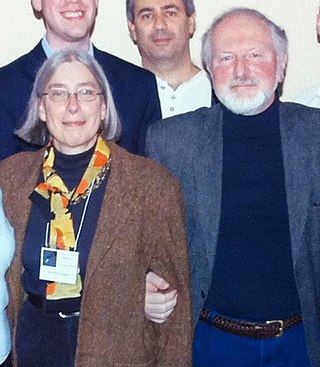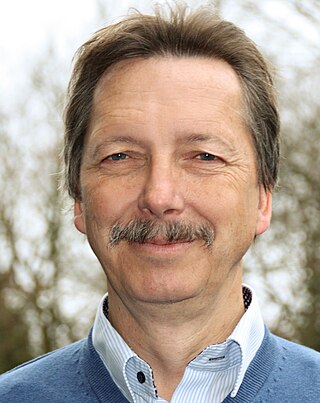Related Research Articles

Gerard Peter Kuiper was a Dutch astronomer, planetary scientist, selenographer, author and professor. He is the eponymous namesake of the Kuiper belt.
Catharine "Katy" D. Garmany is an astronomer with the National Optical Astronomy Observatory. She holds a B.S. (astrophysics), 1966 from Indiana University; and a M.A. (astrophysics), 1968, and Ph.D. (astronomy), 1971, from the University of Virginia. Catharine's main areas of research are massive stars, evolution and formation; astronomical education.

Peter Goldreich is an American astrophysicist whose research focuses on celestial mechanics, planetary rings, helioseismology and neutron stars. He is the Lee DuBridge Professor of Astrophysics and Planetary Physics at California Institute of Technology. Since 2005 he has also been a professor at the Institute for Advanced Study in Princeton, New Jersey. Asteroid 3805 Goldreich is named after him.

Claire Ellen Max is a Professor of Astronomy and Astrophysics at the University of California, Santa Cruz (UCSC) and is affiliated with the Lick Observatory. She is the Director of the Center for Adaptive Optics at UCSC. Max received the E.O. Lawrence Award in Physics.
Daniel Apai is a professor and astrophysicist at The University of Arizona in Tucson, Arizona. He is known for his studies of astrobiology, extrasolar planets, and the formation of planetary systems. He is the principal investigator of the Earths in Other Solar Systems team of NASA's Nexus for Exoplanet System Studies and the Hubble Space Telescope Cloud Atlas Treasury program, and Project EDEN, a large survey for habitable planets in the immediate solar neighborhood. He is leading the Nautilus Space Observatory space telescope concept and co-leading the technology development underpinning it.

Martha Patricia Haynes is an American astronomer who specializes in radio astronomy and extragalactic astronomy. She is the distinguished professor of arts and sciences in astronomy at Cornell University. She has been on a number of high-level committees within the US and International Astronomical Community, including advisory committee for the Division of Engineering and Physical Sciences of the National Academies (2003–2008) and Astronomy and Astrophysics Decadal Review. She was a vice-president of the executive committee of the International Astronomical Union from 2006–2012, and was on the board of trustees of Associated Universities Inc from 1994 until 2016, serving two terms as board chair and one year as interim president.
Todd Jackson Henry is an American astronomer and Professor of Astronomy at Georgia State University, Atlanta, Georgia. He is founder and director of the Research Consortium On Nearby Stars.

Reta F. Beebe is an American astronomer, author, and popularizer of astronomy. She is an expert on the planets Jupiter and Saturn, and the author of Jupiter: The Giant Planet. She is a professor emeritus in the Astronomy Department at New Mexico State University and 2010 winner of the NASA Exceptional Public Service medal.

David Morrison is an American astronomer, a senior scientist at the Solar System Exploration Research Virtual Institute, at NASA Ames Research Center in Mountain View, California. Morrison is the former director of the Carl Sagan Center for Study of Life in the Universe at the SETI Institute and of the NASA Lunar Science Institute. He is the past Director of Space at NASA Ames. Morrison is credited as a founder of the multi-disciplinary field of astrobiology. Morrison is best known for his work in risk assessment of near Earth objects such as asteroids and comets. Asteroid 2410 Morrison was named in his honor. Morrison is also known for his "Ask an Astrobiologist" series on NASA's website where he provides answers to questions submitted by the public. He has published 12 books and over 150 papers primarily on planetary science, astrobiology and near Earth objects.

Thomas K. Henning is a German astrophysicist. Since 2001, he is a director at the Max Planck Institute for Astronomy. Henning is an expert in the field of star and planet formation.
Eberhard Grün is a German planetary scientist who specialized in cosmic dust research. He is an active emeritus at the Max Planck Institute for Nuclear Physics (MPIK), Heidelberg (Germany), research associate at the Laboratory for Atmospheric and Space Physics (LASP) in Boulder (Colorado), and was a professor at the University of Heidelberg until his retirement in 2007. Eberhard Grün has had a leading role in international cosmic dust science for over 40 years.
Sarah T. Stewart-Mukhopadhyay is an American planetary scientist known for studying planet formation, planetary geology, and materials science. She is a professor at the University of California, Davis in the Earth and Planetary Sciences Department. She was a professor at Harvard University Department of Earth and Planetary Sciences from 2003 to 2014.
Rebekah Dawson is an American astrophysicist and an associate professor of astronomy and astrophysics at Pennsylvania State University. Her research focuses on simulating the evolution of exoplanetary orbits and compositions to better understand how planetary systems form.
Sarah Hörst is an associate professor of planetary sciences at Johns Hopkins University, who focuses on understanding planetary atmospheric hazes, in particular the atmosphere of Saturn's moon Titan.

Faith Vilas is an American planetary scientist and Director of the MMT Observatory in Arizona.

Elisabetta "Betty" Pierazzo (1963-2011) was a senior scientist at the Planetary Science Institute from 2002 to 2011. Pierazzo specialized in impact cratering. She was also an adjunct professor at the University of Arizona.
Paola Caselli is an Italian astronomer and astrochemist known for her research on molecular clouds, star formation and planet formation, and the astrochemistry behind the materials found within the Solar System. She is the director of the Max Planck Institute for Extraterrestrial Physics near Munich in Germany. She also holds an honorary professorship at Ludwig Maximilian University of Munich.
Kathleen DeGioia Eastwood is an American astronomer known for her research on the formation and evolution of massive stars, and for her work on undergraduate education in astronomy. She is a professor emerita of astronomy and planetary science at Northern Arizona University.
Katharina Lodders is a German-American planetary scientist and cosmochemist who works as a research professor in the Department of Earth and Planetary Sciences at Washington University in St. Louis, where she co-directs the Planetary Chemistry Laboratory. Her research concerns the chemical composition of solar and stellar environments, including the atmospheres of planets, exoplanets, and brown dwarfs, and the study of the temperatures at which elements condense in stellar environments.
Christine Floss (1961–2018) was a German-born American cosmochemist whose research involved studying the atomic composition of meteorites, interplanetary dust, and moon rocks in order to understand the formation of the Solar System. She was a research professor of physics at Washington University in St. Louis, affiliated with the university's Laboratory for Space Sciences and McDonnell Center for the Space Sciences.
References
- 1 2 AAS Names 23 New Fellows for 2022, American Astronomical Society, 5 January 2022, retrieved 2022-04-22
- ↑ Academic Minute: Dr. Ilaria Pascucci, University of Arizona – Rules of Planetary Placement, WAMC Northeast Public Radio, 11 July 2012
- ↑ "Ilaria Pascucci", PTYS/LPL Faculty, University of Arizona Lunar and Planetary Laboratory, retrieved 2022-04-22
- 1 2 Curriculum vitae , retrieved 2022-04-22